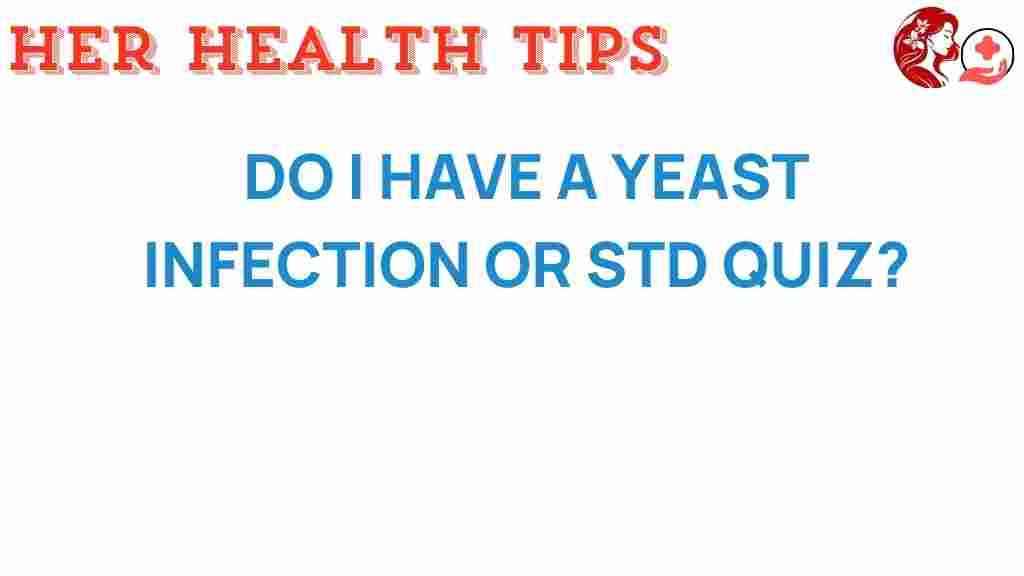Unraveling the Mystery: Do You Have a Yeast Infection or STD?
Understanding the differences between a yeast infection and a sexually transmitted disease (STD) is essential for maintaining good health, particularly for women. Both conditions can cause discomfort and may share similar symptoms, leading to confusion. In this article, we will explore the symptoms of each, how they are diagnosed, and the importance of health awareness in addressing these issues. Whether you are seeking medical advice or just want to increase your knowledge about these infections, this guide will help you distinguish between a yeast infection and an STD.
What is a Yeast Infection?
A yeast infection, also known as candidiasis, is caused by an overgrowth of the Candida fungus, which is naturally present in the body. When the balance of microorganisms is disrupted, Candida can multiply, leading to various symptoms.
Common Symptoms of a Yeast Infection
- Itching and irritation in the vaginal area
- Thick, white, odorless discharge (often resembling cottage cheese)
- Redness and swelling of the vulva
- Pain during intercourse
- Burning sensation during urination
What is an STD?
STDs, or sexually transmitted diseases, are infections that are primarily spread through sexual contact. They can be caused by bacteria, viruses, or parasites and can have serious health consequences if left untreated.
Common Symptoms of STDs
- Unusual discharge from the genitals
- Pain or burning during urination
- Itching or irritation in the genital area
- Soars, blisters, or warts on the genitals
- Pain during intercourse
- Flu-like symptoms (fever, fatigue)
Diagnosing a Yeast Infection vs. STD
Both yeast infections and STDs can present similar symptoms, making accurate diagnosis crucial. Here’s how healthcare providers differentiate between the two:
Diagnosis of Yeast Infection
Diagnosis typically involves:
- A thorough medical history review
- Physical examination of the genital area
- Microscopic examination of vaginal discharge
- Culturing the yeast for identification
Diagnosis of STDs
Diagnosing STDs may require:
- A detailed sexual history
- Blood tests for viral infections (like HIV or herpes)
- Urine tests for bacterial infections (like chlamydia or gonorrhea)
- Swabs from the genital area for laboratory analysis
Health Awareness and the Importance of Getting Checked
Health awareness is key to maintaining good sexual health. Regular check-ups and open communication with healthcare providers can help detect infections early. Here are some points to consider:
- Be aware of your body and any changes in symptoms.
- Engage in safe sexual practices to reduce the risk of STDs.
- Don’t hesitate to seek medical advice if you experience unusual symptoms.
- Regular screenings for STDs are important, especially if you have multiple partners.
- Educate yourself about both yeast infections and STDs.
Infection Quiz: Do You Have a Yeast Infection or STD?
To help you identify whether you may be experiencing a yeast infection or an STD, consider these questions:
- Have you recently had unprotected sex?
- Are you experiencing unusual discharge? What does it look like?
- Do you have any sores or blisters in your genital area?
- Is there itching or burning during urination?
- Have you had previous yeast infections or STDs?
If you answered “yes” to several of these questions, it may be time to consult a healthcare professional for further evaluation.
Troubleshooting Tips for Yeast Infections and STDs
Here are some practical tips to help manage symptoms and prevent future infections:
For Yeast Infections:
- Wear breathable cotton underwear to reduce moisture.
- Avoid scented feminine products and douches.
- Maintain a balanced diet low in sugar.
- Consider probiotics to restore healthy flora.
- Use antifungal medications as prescribed by a doctor.
For STDs:
- Practice safe sex by using condoms consistently.
- Limit the number of sexual partners to reduce risk.
- Get tested regularly for STDs if you are sexually active.
- Communicate openly with your partner about sexual health.
- Seek medical attention immediately if you suspect you have an STD.
When to Seek Medical Advice
If you are experiencing symptoms related to a yeast infection or an STD, it is crucial to seek medical advice promptly. Early diagnosis and treatment can prevent complications and promote better health outcomes.
- If symptoms persist for more than a few days despite home treatment.
- If you develop a fever or systemic symptoms.
- If you have recurrent infections.
- If you suspect you may have been exposed to an STD.
Conclusion
Understanding the differences between a yeast infection and an STD is vital for maintaining women’s health. By being aware of the symptoms, seeking timely diagnosis, and following medical advice, you can take charge of your health. Remember, open communication with healthcare providers and routine screenings are essential components of good sexual health.
For more information on sexual health topics and to stay informed, visit this resource.
Take charge of your health and stay aware! If you have concerns about potential infections, do not hesitate to reach out to a healthcare professional.
This article is in the category Conditions and created by HerHealthTips Team
